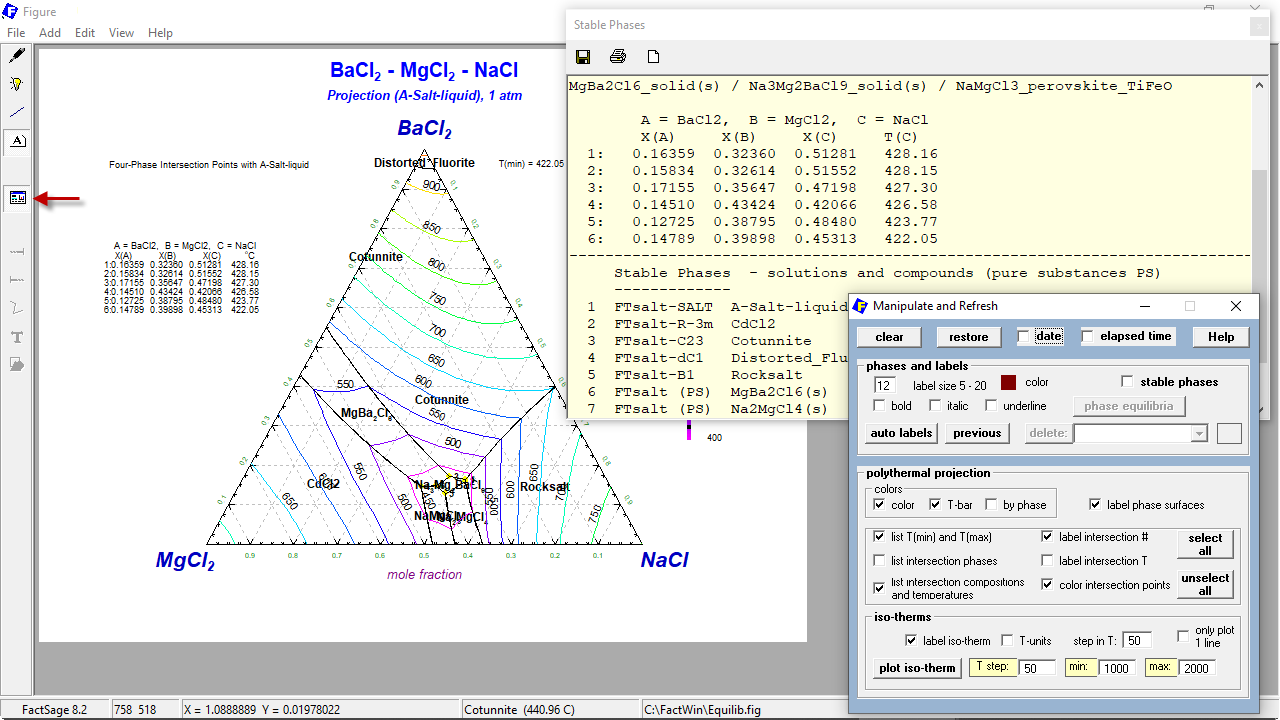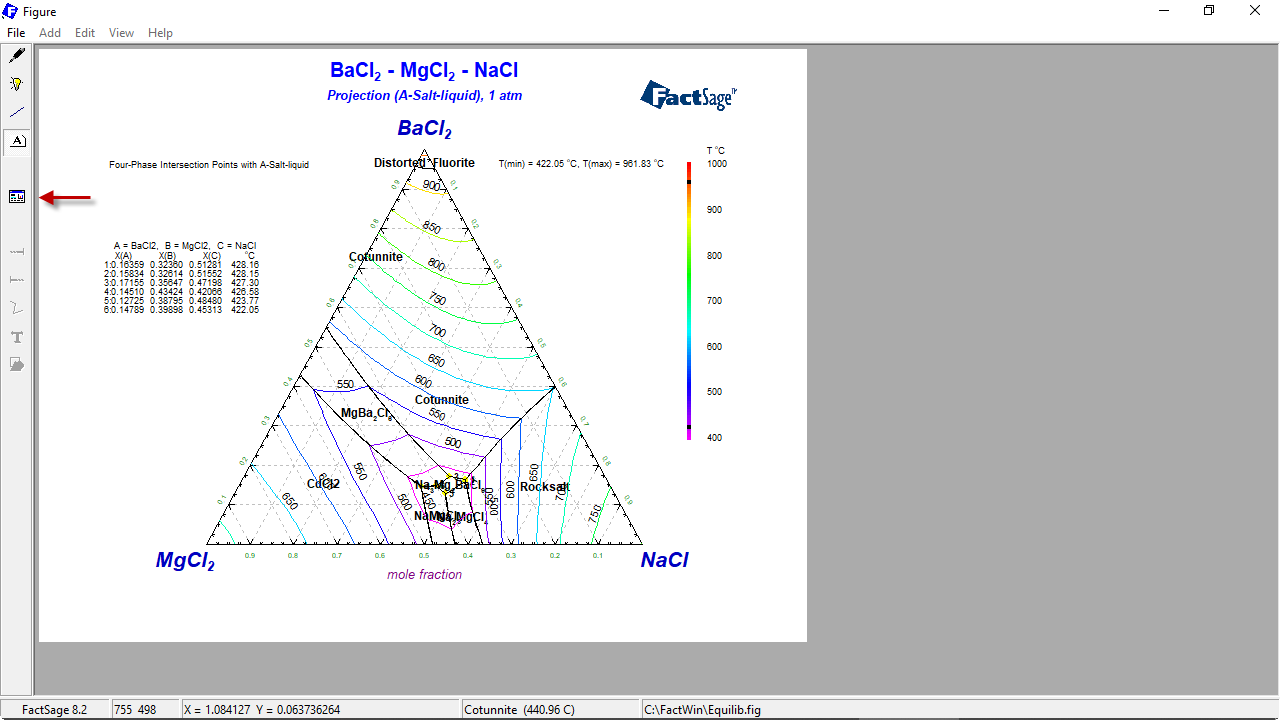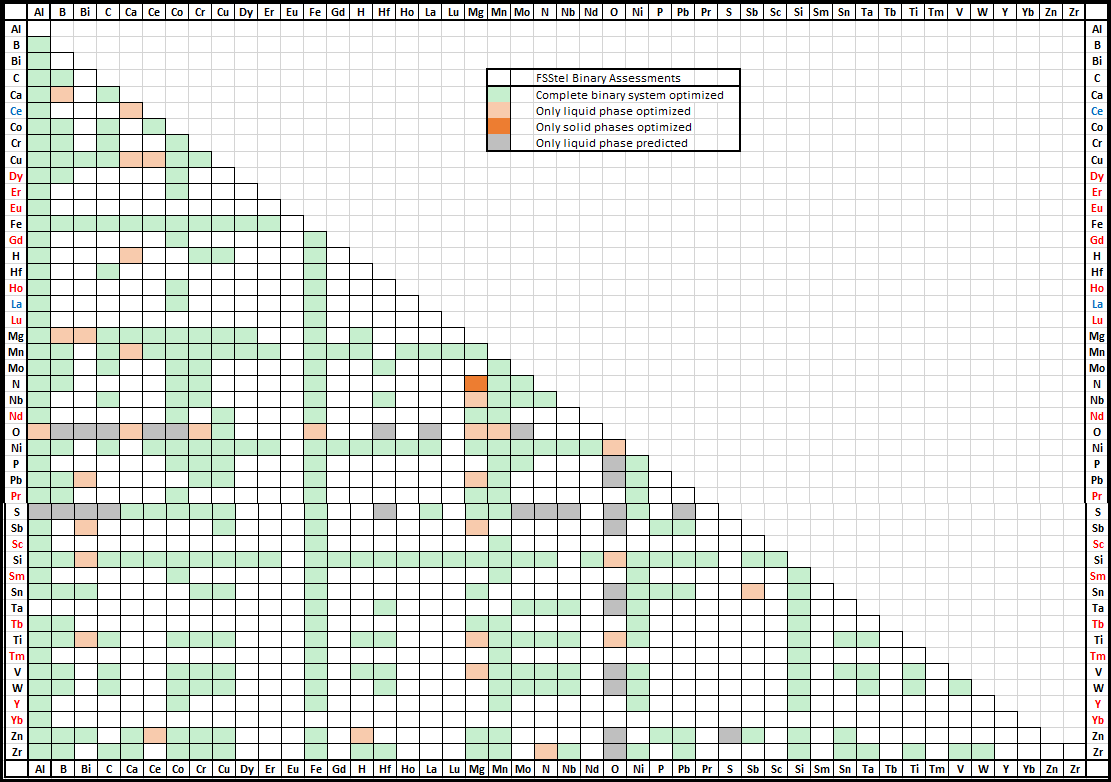1. General:
|
Important! After installation you should periodically check the latest news about FactSage 8.2 where we immediately report any 'bugs' and other issues as they surface.
You can display this latest news
- in the FactSage Main Menu click Alternatively visit www.FactSage.com > 'FactSage 8.2 ~ News ~' |
FactSage 8.2 ~ News ~ |
The 'bugs' and other issues highlighted in the previous 'FactSage 8.1 ~ News ~' have been resolved.
| When FactSage is being loaded and the About Window is displayed, users are now informed about expiration dates of the license and databases. |
|
In the FactSage 8.1 Main Menu Window click
If you are entitled to FactSage 8.2 the file CD-FactSage81.exe (approx. size 350 MB)
will be downloaded to the downloads folder.
Typically this takes 10 - 20 minutes or even longer.
2. Download via www.factsage.com
For details visit www.factsage.com
and click 'Download Service' and then 'FactSage 8.2 Update/Installation'.
FactSage dongle status
- When a valid FactSage dongle is attached to a USB port on the computer you are able to run a standalone version
of FactSage.
If FactSage issues an error message about a 'missing or invalid FactSage security key'
it goes into the FactSage SetUp mode with a green screen.
There are several factors that can cause this to happen.
The 'FactSage dongle status' Window shown here is for an installation where a valid FactSage dongle
is attached and everything is in order (i.e. 1 - 5. All OK).
The FactSage 8.2 Installation program enables you to update/refresh FactSage 8.2 software,
documentation and databases to the full FactSage 8.2 package.
You can upgrade FactSage 8.0 - 8.1 to FactSage 8.2.
However we recommend that you do not upgrade any FactSage 7.0 - 7.3
currently installed on your computer.
You can update/refresh a FactSage Standalone computer or a Network
Server. In the case of a network installation it is
only necessary to update/refresh the Network Server.
If your computer has access to the Internet you can use FactSage 8.2 to download and update various
FactSage files from www.factsage.com.
Information on updates ...
- your computer has access to www.factsage.com
When you first run FactSage 8.2 the program tries to connect to www.factsage.com and check if
your installation has the latest Profiles82.ini.
If you have checked
All of these actions will be done automatically.
Important - after updating the profiles file it is no longer necessary for you to quit FactSage and refresh the installation.
When you first run FactSage 8.2 the program tries to connect to www.factsage.com and check if
your installation has the latest special databases and patches.
If you have checked
For example,
Windows Defender (Microsoft Security)
may suddenly decide a particular file (for example FS-Copy.exe)
is a virus threat and delete it without notifying you.
The rules of virus detection are constantly evolving.
Even if a particular file has not been updated
a file considered safe yesterday may be classified as a threat today.
When an important file is missing you will now be made aware of the problem.
Note:
A new slide show for Optisage - the Calphad Optimizer - has been added.
The slide shows
New Apps, Add-ons and their associated files can be stored in the sub-folder \Add-ons_Apps.
The menu command lines for the Add-ons etc.
are stored in this sub-folder in the text file Add-ons_Apps.dat that you can edit.
This new option is directed to both regular and advanced users. It is versatile and simple to program.
The following is a partial listing from the file showing the 4 command lines associated with the screenshot below.
There is no limit to the number of add-ons, apps and shortcuts that can be included in the Add-ons Menu.
For more details click 'Add-ons > Add-ons, apps and shortcuts ...'
- c:\Program Files (x86); Windows Defender and CPU;
Renaming the FactSage folder; HTTP vs HTTPS; Windows 11
We encourage users to install FactSage in the root directory, for example c:\FactSage, c:\FactSage82, etc.
In FactSage there are over 17,000 files. With Windows Explorer it is easy to access the FactSage main folder (c:\FactSage etc.) and its subfolders that contain data (\FACTDATA), documents (\FACTHELP), figures (\FIGURES), macros (\MACROS\, etc. Private user folders (\PRIVATE, \USER ..) can be readily created and user files (*.equi, *.phas ..) easily moved between the subfolders.
However IT may prefer you to install FactSage in c:\Program Files (x86) with the other 32-bit applications (do not store in c:\Program Files which is reserved for 64-bit applications).
Installing in c:\Program Files (x86) is acceptable but it is not as easy to manipulate the files in c:\Program Files (x86) \FactSage. Care must be taken not to affect other applications. Note, all the data and user files will also be stored in c:\Program Files (x86) \FactSage and not in c:\ProgramData.
The Antimalware Service Executable (MsMpEng.exe) is a background-running anti-virus service in Windows Defender. It may have a detrimental effect on CPU and cause unnecessary delays when running FactSage. The effect on CPU is displayed by the Task Manager (to bring up the Task Manager press Ctrl+Shift+Esc).
With all the FactSage programs and data stored in the one location it is fairly easy to add the root directory (c:\FactSage, c:\FactSage82, etc.) to the Windows Defender's Exclusion List and stop Windows Defender from unnecessary file checking.
For example, go to Start > Settings > Update & Security > Windows Security > Virus & threat protection. Under Virus & threat protection settings, select Manage settings, and then under Exclusions, select Add or remove exclusions. Select + Add an exclusion > Folder > ...
For more details Google 'Add an exclusion to Windows Security'.
Renaming the FactSage directory is straight forward. Let us say FactSage is installed in c:\FactSage81 but you wish to change the name to c:\FactSage82
2. Locate the text file Factwin.ini - i.e. c:\FactSage82\Factwin.ini.
Or you can edit the text file Factwin.ini and globally change all text strings 'c:\FactSage81' to
'c:\FactSage82'
3. When you run FactSage (c:\FactSage82\FactSage.exe) the new/edited Factwin.ini will be refreshed.
4. You may wish to edit the FactSage short-cut on the screen and change its name and properties.
Point to the FactSage icon on the screen, mouse-right-click and select Rename and Properties.
Most of our URL links have been converted to the more secure HTTPS protocol - for example
https://www.FactSage.com - FactSage home page; https://www.crct.polymtl.ca - CRCT home page;
https://gtt-technologies.de - GTT-Technologies home page.
In addition to encrypting the data transmitted between the server and your browser, the HTTPS protocol protects the transmitted data from being tampered.
To date we have seen no major issues when running FactSage 8.2 under Windows 11.
New documentation has been added in FactSage 8.2 to help new users get started with FactSage and to help experienced users select the databases.
FactSage - how to get started
This is directed to the new FactSage user.
It shows how to access the documents and makes recommendations on which slides shows to check out first.
It makes suggestions on the best way to learn about FactSage.
How to Select Databases and Phases in FactSage Calculations
This is directed to the FactSage user who wants to know more about using the databases.
It shows how to select the databases, how to select the compounds and solution phases in those databases,
and how to proceed.
This is new in FactSage 8.2 and is available to CRCT Customers - i.e. User IDs 1 - 5000.
This lists the name and email address of your FactSage representative who you contact for information about your
Maintenance and Service Contract - i.e. renewal and expiration dates.
This lists the name and email addresses of all the users of your particular installation (User ID).
Only users running FactSage with the same ID can see this display.
In addition, the key FactSage contact person at your installation is identified.
This enables any user at this installation to modify (add, change, delete) his name and email address.
FactSage-TEACH is a selftuition package on FactSage developed by GTT-Technologies.
It is combination of a special handbook, a series of special mini-databases for use with the assignments,
and a special flowsheet model for the Silicon Arc Furnace process.
It is the result of a long series of seminars, training courses and workshops on Computational Thermochemistry
which began in the early nineties using ChemSage.
For more information including the 'Table of Contents' click 'General > FactSage-TEACH > Introduction ...'.
FactSage 8.2 contains the new FactSage-Teach Version 2.1.
Corrections and amendments have been made to "Section 1-Theoretical background"
and "Section 3-Guided instructions".
The total number of stored phase diagrams has been increased by over 750.
This is a completely new concept that was introduced in FactSage 8.1 and is directed towards advanced users.
FactSage permits the use of "virtual elements" with chemical symbols
Qa, Qb, Qc, .., Qz with atomic weights of 0.0.
Virtual elements may be used in the Apps Equilib, Phase Diagram, Compound and Solution
in the same way as real elements.
The use of virtual elements was presented in FactSage 8.1 -
Virtual Elements - Equilib and
Virtual Elements - Phase Diagram.
To date this has worked well and requires no updating.
The Microstructure app calculates the thermal conductivity of microstructures.
It was first introduced in FactSage 8.1.
In FactSage 8.2 the Microstructure app and its slide show have been revised and updated.
The app is now accessible as an Add-on.
Equilib Slide Shows - 'Equilib > Reactants Window > Help > Slide Show > Thermal conductivity of microstructures ..'
The app is also accessible as an Add-on
The dimension limits of the system variables
(number of elements, reactants, selected species, etc.)
are posted in the Parameters Window
In FactSage 8.2
For example the following line command stored in \Add-ons_Apps\Add-ons_Apps.dat
;EquiSage.exe /EQUILIB /MACRO Macros\EquiEx_SET_Variables.mac; ;Run Equilib macro ; ;
will run the macro Macros\EquiEx_SET_Variables.mac.
For more details click 'Add-ons > Add-ons, apps and shortcuts ...'
In FactSage 8.2 the following new commands and variables have been added to the macro processing.
Some minor bugs have been fixed.
The app is also accessible as an Add-on
This is a completely new concept that was introduced in FactSage 8.1 and is directed towards advamced users.
It works well and requires no changes.
In FactSage 8.2 there are now two OptiSage Apps - the traditional module that was developed in the early 2000's, and a new module that has been completely re-written.
To reflect this major change the new app is named Calphad Optimizer.
The aim of a Calphad optimization is the determination of thermodynamic parameters that allow reproduction of all available experimental data.
The Calphad Optimizer is combining a clear and easy to understand user interface with strong optimizers and extensive user feedback.
Most popular experimental data types are pre-defined and there is a test option to detect typos as soon as they are made.
Two different optimizers (Gaussian Process and NOMAD) are included and the user is presented with feedback during and after the optimization.
Through the feedback, Calphad Optimizer gives you control over the optimization progress - you are able to see the current status of the optimization and what experiment and fitting parameters are most sensitive.
Note:
The Calphad Optimizer is not included with the standard FactSage installation because of the large size
of the OptiSage package (1.3 GB).
It is necessary to download the packge from the Internet.
The Viscosity App in FactSage 8.2 performs calculations approximately
ten times faster than in earlier FactSage versions.
In FactSage 7.3 GTT-Technologies developed a new utility, ConvTDB,
whereby Thermochemical Database (TDB) format could be converted to FactSage
databases (.cdb .sln .fdb) format. ConvTDB has proved to be very useful.
Following the feedback from users ConvTDB has been updated for FactSage 8.2.
In addition, a minor bug leading to underestimation of stability of pure magnetic elements has been fixed.
All calculated equilibria have been corrected, only the activity information of pure elements might have been wrong.
Solid salts
Solid oxides
In FactPS 8.2
there are a total of 4952 compounds and 7076 phases.
FTlite 8.2 is a major update of the database.
A total of 932 binary systems (vs 864 in 8.1) have been evaluated,
for most of them over the entire range of composition and for all stable phases.
Several dozen ternary systems have been assessed, and important quaternary systems have also
been evaluated.
FTlite 8.2 contains 289 solution phases (vs 261 in 8.1) and 2064 pure compounds
(vs 1774 in 8.1) with 2175 stoichiometric phases counting allotropic forms.
In addition the volumetric properties (density @298.15 K, thermal expansion and compressibility B')
and thermal conductivities have been entered for the following solid compounds
(124 additions):
Complete details on FTlite 8.2 including all the phase diagrams are given in the
updated Documentation in the FactSage Main Menu Window.
In FactSage 8.2 the updates to FToxid include the following evaluations:
In combination with the new FTsulf database,
the updated FToxid database allows calculations of Cu, Ni, Pb, Zn, and As distributions between slag, liquid sulfide (matte) and liquid alloy.
Several solid solutions have been updated: Spinel (Ca and Cu added), Corundum (Ni added), Willemite (Ni added), Rhodonite (Ni added), and Monoxide.
About a dozen stoichiometric compounds containing Cu, Ni or As have been added or modified.
In addition the
Volumetric properties (density @298.15 K, thermal expansion and compressibility B')
and thermal conductivities
have been entered for the following solid oxide compounds (158 additions and modifications):
Complete details on FToxid 8.2 including all the phase diagrams are given in the updated Documentation in the FactSage Main Menu Window.
For nearly all calculations involving sulfide solutions, the FTsulf databases
supersede the FTmisc databases.
In particular for calculations involving matte smelting, the FTsulf databases
will provide better results in nearly all cases due to many improvements to the optimizations
[2135-2139, 4023-4028, 4031-4035].
For example, the MAT2 phase is now more consistent with the FToxid
and FSstel databases, contains oxygen as a component,
and can be used at all compositions from pure metal to pure sulfide.
FTsulf 8.2 should NOT be used simultaneously with the
FTlite, FScopp or FSlead databases.
Complete details on FTsulf 8.2 including all the phase diagrams are given in the updated Documentation in the FactSage Main Menu Window.
The FTsalt databases contain data for pure salts and salt solutions of 27 main cations:
and 10 main anions:
F, Cl, Br, I, NO2, NO3, ClO4, OH, CO3, SO4 as well as for dilute solutions of O2- and OH- in the molten salt phase.
In FTsalt
volumetric properties (density @298.15 K, thermal expansion and compressibility B')
and thermal conductivities
have been entered for the following compounds and solutions (99 additions and modifications):
Solid salts (94 phases)
Liquid salts (5 phases)
Four new compounds LiClO4, LiNO2, KLi(NO3)2 and KLi3(NO2)4 have been added to the compound database
and three compounds LiNO3, Li2CO3 and KLiCO3 have been updated.
LiClO4 has been added to the PERC solid solution,
and two new LiNO2-rich solid solutions (LiNA and LiNB) have been introduced.
The SALTK liquid solution permits calculations for nitrate-rich solutions.
The reciprocal ternary sub-systems
Na, Li // NO3, NO2; K, Li // NO3, NO2; Na, Li // NO3, Cl; K, Li // NO3, Cl; Na, Li // NO3, CO3; K, Li // NO3, CO3; Na, Li // NO3, ClO4 and K, Li // NO3, ClO4
have been newly evaluated and optimized at all compositions (including all binary common-ion sub-systems), based on the experimental data available in the literature.
This includes updates for the K2CO3-Li2CO3, KNO3-LiNO3, Li2CO3-LiCl, Li2CO3-LiNO3, Li2CO3-Na2CO3, LiCl-LiNO3 and LiNO3-NaNO3 binary sub-systems.
In SALTK, LiX-NaX, LiX-KX and NaX-KX (where X = NO2, Cl, CO3 or ClO4) as well as LiCl-Li2CO3, NaCl-Na2CO3 and KCl-K2CO3
(which were already available in SALTF) are the only solute-solute binary common-ion sub-systems that have been optimized.
Note that reactions of the type 4 ANO2 + BClO4 = 4 ANO3 + BCl (where A, B = Li, Na or K) have a very negative Gibbs energy change and thus are strongly shifted to the right. In order to inhibit those reactions (which may be kinetically hindered), it is possible to use virtual elements (This new feature was introduced in FactSage 8.1). Some detailed examples are provided in the Equilib Advanced Slide Show (see in particular example 15.6).
The total number of stored FTsalt phase diagrams
is now 367 (was 351 in 8.1).
Complete details on FTsalt 8.2 including all the phase diagrams are given in
Documentation in the FactSage Main Menu Window.
The FTmisc databases contain data for
sulfides, alloys, etc.
In FTmisc 8.2
the MAT2 liquid sulfide/metal solution, and all solid solutions and stoichiometric compounds compatible with it, have been moved to the new FTsulf 8.2 database.
For the matte smelting system (S-Cu-Fe-Ni-Co-Pb-Zn-As), the remaining sulfide solid solutions and stoichiometric compounds are compatible with liquid matte [FTmisc-MATT]. This system has been superseded by the new FTsulf 8.2 database, which provides equally good or better results for most applications.
Complete details on FTmisc 8.2 including all the phase diagrams are given in Documentation.
Several dozen ternary systems have been assessed, and important quaternary systems have also been evaluated.
Complete details on FScopp 8.2 including all the phase diagrams
are given in 'Documentation' in the FactSage Main Menu Window.
FSlead
is designed for thermodynamic and phase equilibrium calculations involving Pb alloys.
Several dozen ternary systems have been assessed, and important quaternary systems have also been evaluated.
Complete details on FSlead 8.2
including all the phase diagrams are given in
'Documentation' in the FactSage Main Menu Window.
With the addition or update of 16 rare earth elements (RE) the FactSage 8.2 database now contains 46 elements (was 32 in FactSage 8.1):
The database related to Nd magnet (Fe-Nd-B-Dy-Pr-Tb) and its recycling process using liquid metal has been updated.
The updates include 87 new binary, 7 updated binary, 10 new ternary and several new quaternary and high order systems.
11 new solution phases and 452 new compounds have also be added.
The total number of stored FSstel phase diagrams
is now 307 (was 304 in 8.1).
Complete details on FSstel 8.2 including all the phase diagrams are given in 'Documentation' in the FactSage Main Menu Window.
The 79 elements included in the database are,
100 new binary systems and 1 ternary system have been added and 17 systems have been updated.
Complete details on SGTE(2022) with revised documentation and all the calculated
phase diagrams are given in Documentation in the FactSage Main Menu.
The elements included in SpMCBN are:
Al, Ca, Co, Cr, Fe, Hf, Mg, Mn, Mo, Nb, Ni, Re, Sc, Ta, Tc, Ti, V, W, Y, Zr
In FactSage 8.2 modelling of approximately 60 'end-members' associated with several different phases
has been completed to allow calculations for 4- or higher-component systems.
Such calculations should be viewed as interpolations of somewhat lower accuracy than that associated with the fully assessed lower-order systems.
In addition, a small adjustment to the assessed data for the liquid phase of the Nb-C system now avoids calculation of an inverse miscibility gap at very high temperatures in the liquid phase.
Complete details on SpMCBN 8.2 including all the phase diagrams are given in
Documentation in the FactSage Main Menu.
What's New in:
What's New in: - if the following link is not found on your computer click on www.factsage.com
1. Download FactSage 8.2 via FactSage 8.1
For certain installations it may not be possible to download the file - for example you may get an
error message such as 'webpage cannot be found'.
This could be because the security settings on your computer are blocking the transfer of a ".exe" file
or the file is too large to be downloaded.
Check with your IT group.
Tools > FactSage Updates >Download the complete FactSage 8.2 Update/Installation Package .
The FactSage dongle status displays the status of the FactSage dongle attached to the computer.
This helps you to diagnose the source of the error message.
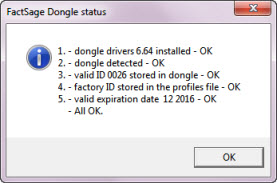

In the FactSage Main Menu click Tools > FactSage Updates
to display the following options:
- for details on the following options
- to list the files that can be updated
- to update/refresh your FactSage 8.2 expiration dates
This avoids the necessity to manually download and install an updated Profiles82.ini.
(Note, this update operation can now be done automatically - see Automatically update Profiles82.ini below).
- to update and install the latest FactSage 8.2 patches.
This avoids the necessity to manually download and install the FactSage 8.2 patches.
- the most recent FactSage 8.2 Package (CD-FactSage81.exe)
with the latest profiles file, Profiles82.ini.
- this will be available after FactSage 8.2 has been released at a future date.
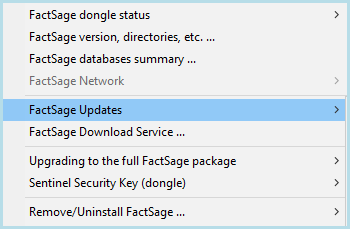
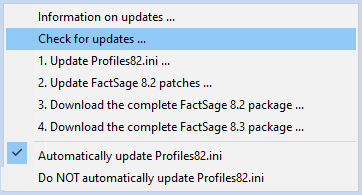
![]() Automatically update Profiles82.ini
- this option is new in FactSage 8.2
Automatically update Profiles82.ini
- this option is new in FactSage 8.2
- when necessary the latest Profiles82.ini is updated
and the FactSage 8.2 expiration dates are automatically refreshed.
Any new special database FSstel, FTlite, SpMCBN, etc. and dongle will be refreshed at the same time.
This is the recommended setting.
- in order to update Profiles82.ini you must first select
Check for updates ...
and then select 1. Update Profiles82.ini.
This setting is not recommended.
For the updating to succeed the following conditions must be satisfied:
- you are running FactSage 8.2 as a standalone or server installation i.e. not network client installation
![]() Automatically update Profiles82.ini the latest profiles file is downloaded and installed.
In such a case you are notified that the following operations will be performed:
Automatically update Profiles82.ini the latest profiles file is downloaded and installed.
In such a case you are notified that the following operations will be performed:
![]() Automatically update Profiles82.ini
the latest profiles file is downloaded and installed as shown above.
Automatically update Profiles82.ini
the latest profiles file is downloaded and installed as shown above.
However, if you have NOT checked
Automatically update Profiles82.ini
when necessary an 'Updates are ready.' message is posted in the FactSage Main Menu.

This was first introduced in FactSage 8.0.
Each time FactSage is run a check is performed to make sure the important installation files (principally *.exe and *.dll)
have not been inadvertently deleted.
The *.exe and *.dll files are regularly vetted for viruses via www.virustotal.com
that has access to over 70 antivirus software.
Whenever the antivirus software reports suspicious behavior in one of our files
we try and contact the antivirus vendor and report the file as a false-positive.
FactSage Overview - a quick look at FactSage Modules and Databases
have been updated.
FactSage Browser - a navigation tool for database documentation
Compound - for the Compound App
This is new in FactSage 8.2.
You can run Apps, Add-ons and shortcuts through the new FactSage Add-ons Menu.
;Microstructure.exe ;EQUIThermCond.pptx ;Microstructure App ; The Microstructure App is used calculate the thermal conductivities of microstructures. Model parameters for thermal conductivity calculations are available in several FactSage databases. _ _ The thermal conductivity of phases can be calculated as a function of temperature, porosity (intragrain porosity) and size (average grain size).;
;EquiSage.exe /F90IOe /TDB /EQUILIB ;ConvTDBintro.htm ;ConvTDB App to import TDB files ; ConvTDB converts a TDB file to produce both compound (.cdb files) and solution (.sln .fdb files) databases. _ _ In FactSage such databases are stored in separate files.;
;EquiSage.exe /EQUILIB /FTOPT ;FactOptimal.ppt ;FactOptimal shortcut ; This shortcut runs Equilib and loads FactOptimal ;
;EquiSage.exe /EQUILIB /MACRO Macros\EquiEx_SET_Variables.mac; ;Run Equilib macro ; Run macro Macros\EquiEx_SET_Variables.mac
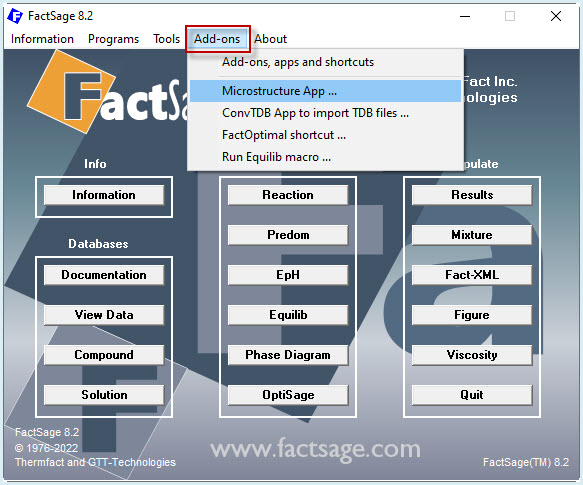
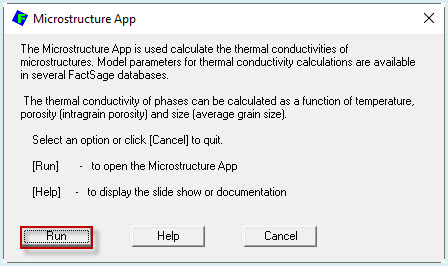
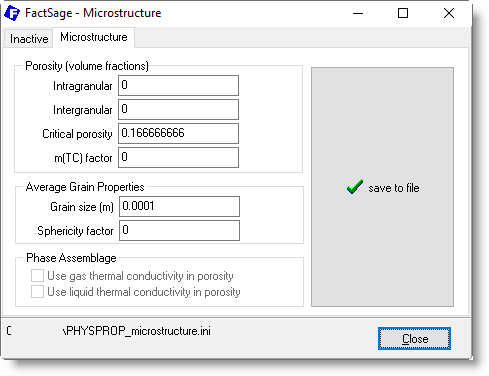
1. Use the Windows Explorer and rename c:\FactSage81 as c:\FactSage82
You can delete Factwin.ini in which case a new Factwin.ini will be generated with default settings.
This will assure that the list of connected databases, the list previous files and other personal settings are retained.
But be careful when editing, do not corrupt the file!
2. Apps:


For a given user ID the following items are posted.
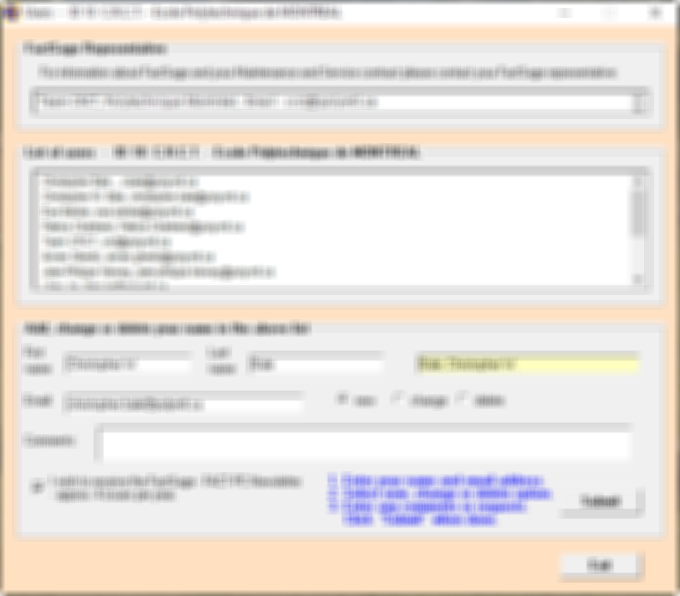

Major changes have been made to "Section 2-Practical assignments". These include
- Higher compatibility with FactSageEdu the free FactSage Education version
- New assignments: 3.10, 3.11
- Extended and/or modified assignments: 1.3, 1.5, 2.1, 3.8, 4.3
- Corrections, clarifications and additional explanations
- Updated results and databases.
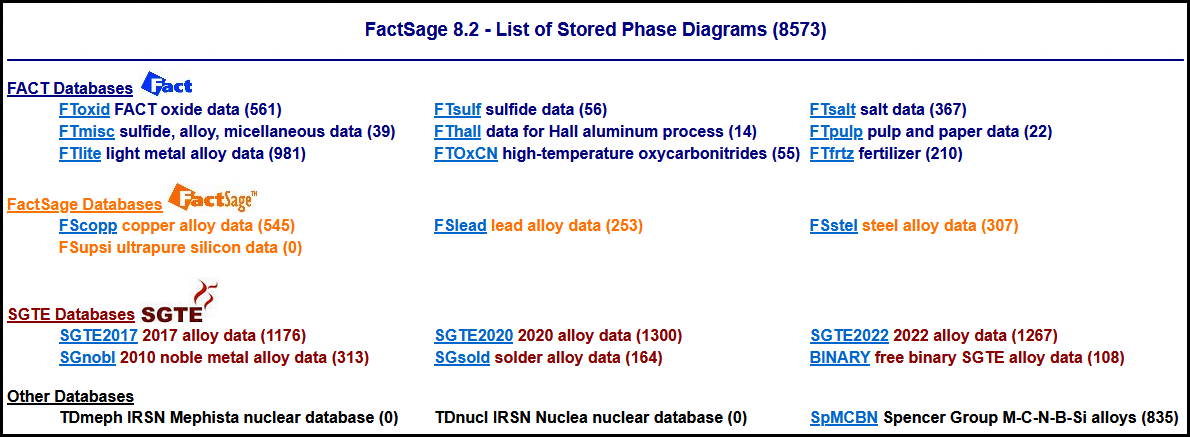
The link What's New in View Data has been updated and
gives a summary of the more important programming changes in View Data that have appeared
since FactSage 6.1 (2009) until now FactSage 8.2 (2022).
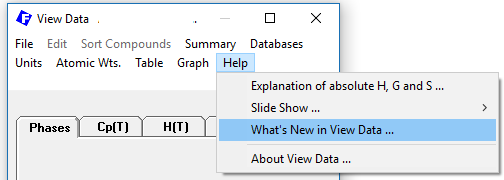
The link What's New in Equilib has been updated
and gives a summary of the more important programming changes in Equilib that have appeared
since FactSage 6.1 (2009) until now FactSage 8.2 (2022).
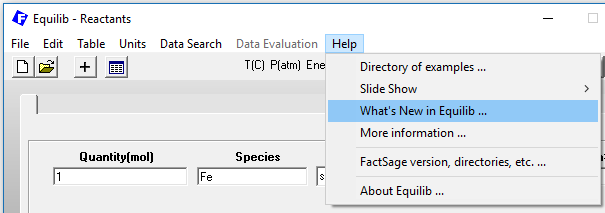
- in the FactSage Menu Window click Add-ons > FactOptimal ...
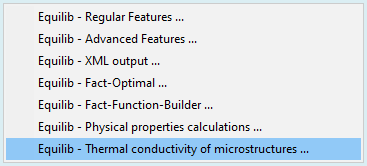
- the maximum number of components (elements + phase electrons) is now 70 (was 48)
These new limits should help address dimension issues that can arise with large calculations involving FToxid data.
- the maximum number of selected species is now 7000 (was 5000)
With the new FactSage Add-ons menu it is possible to run a Macro from the
FactSage Menu Window as shown in the screenshot.

SET PARAMETERS HISTORY ON (OFF)
- save previous Equilib calculations
- when the macro processing is finished the History option is returned to its original setting.
List Window Values: $L_...$
- these values apply to all possible species and phases.
$L_Mgas$ = total number of list gas species
$L_Mliquid$ = total number of list liquid species
$L_Msolid$ = total number of list solid species
$L_Maqueous$ = total number of list aqueous species
$L_Mcompound$ = total number of list compound species = $L_Mgas$ + $L_Mliquid$ + $L_Msolid$ + $L_Maqueous$
$L_Msolution$ = total number of list solution species
$L_Mtotal$ = total number of list species = $L_Mcompound$ + $L_Msolution$
$L_+*$ = '+' column for list species * - * = 1 - 7000
'0' not selected, '*' single phase, 'I' 2-phase, 'J' 3-phase,
'M' metastable (dormant), 'F' formation target, 'P' preciptate target, 'A' fixed activity
List Species: $L_s?*$ - list species * = 1 - 7000; ? = a, n, N, P ...
- note the values of * are fixed and are not affected by the species selection.
$L_sa*$ = list species activity
$L_sn*$ = list species moles
$L_sN*$ = list species name
$L_sP*$ = list species phase state: 1 = gas, 2 = liquid, 3 = aqueous, 4 = solid, 5+ = solution
Example is given in the new EquiEx_List_Window.mac located in the Macros Folder.
KILL (DEL DELETE) COPY RENAME
- file names .equi, .phas and .mixt have been added to the commands.
The complete list of files is now .dat .equi .fig .phas .mac .mixt .res .tab .txt .xml .xls .xlsx

- in the FactSage Menu Window click Add-ons > FactOptimal ....
The link What's New in Phase Diagram has been updated and
gives a summary of the more important programming changes in
Phase Diagram that have appeared since FactSage 6.1 (2009) until now FactSage 8.2 (2022).
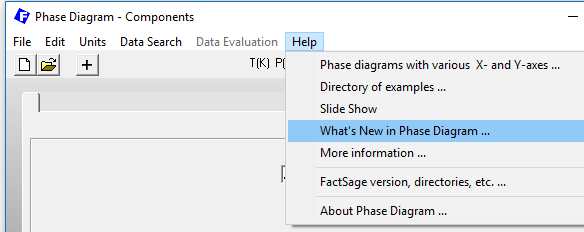
The OptiSage App is used for the assessment of Gibbs energy data.
Various types of experimental data (phase diagram, enthalpy, activity data etc.) can be utilized in order to generate optimized parameters for the Gibbs energies of stoichiometric compounds as well as the excess coefficients of a wide range of non-ideal solution models.
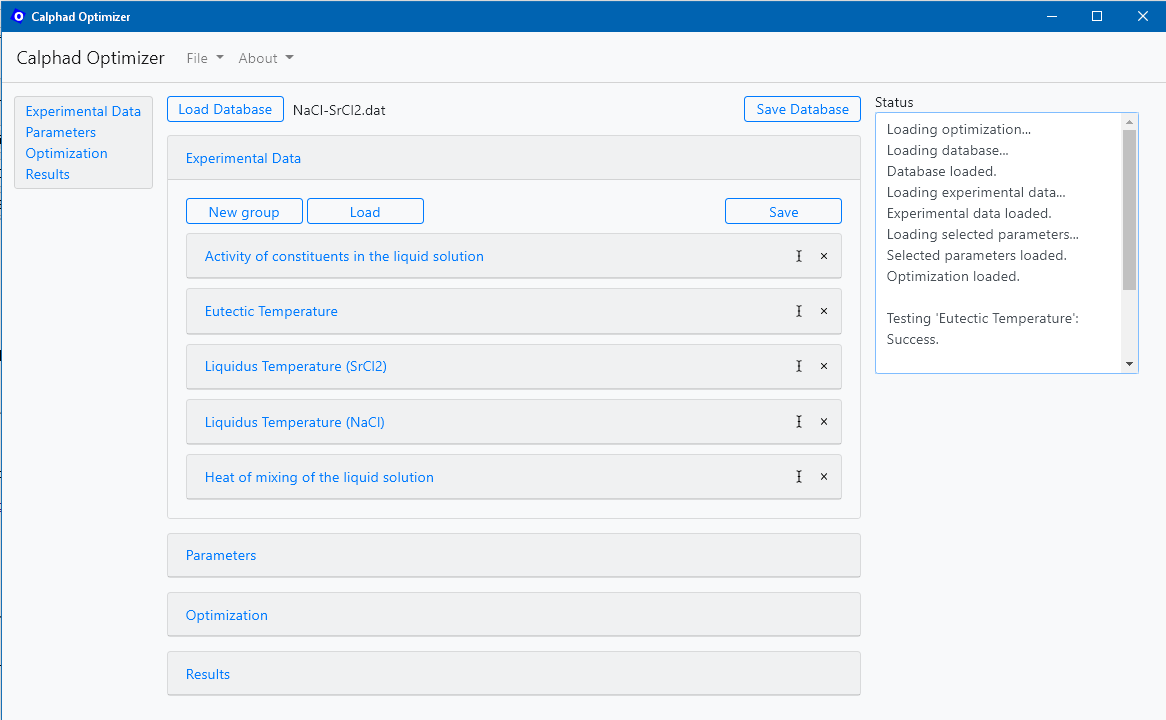
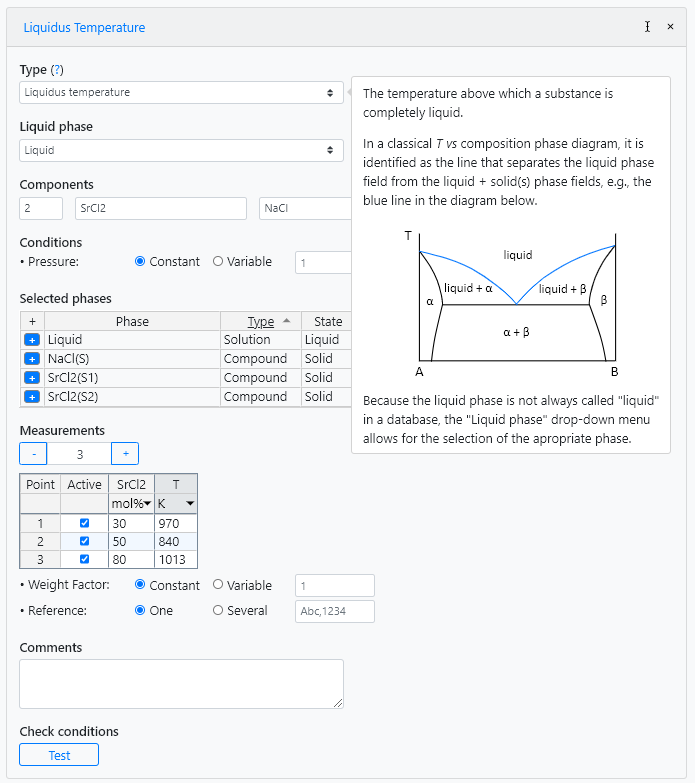
![]()
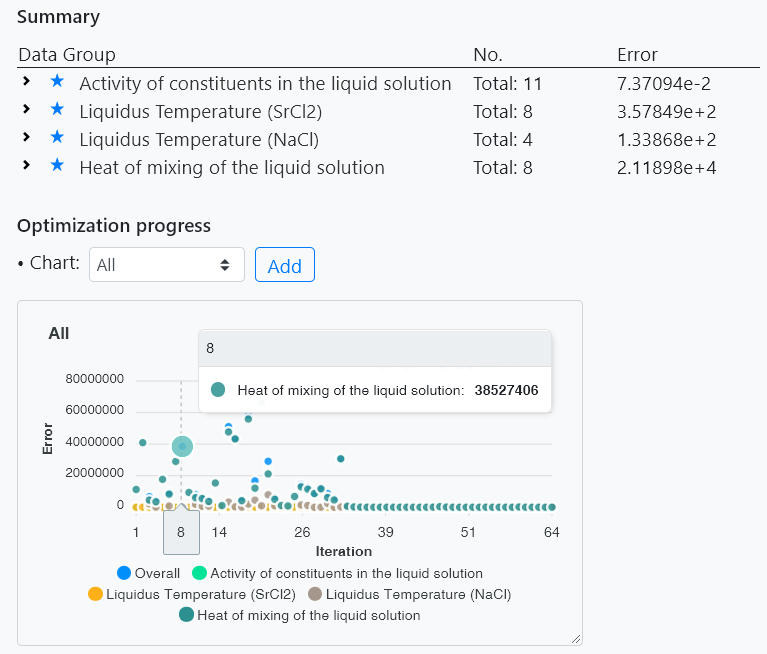
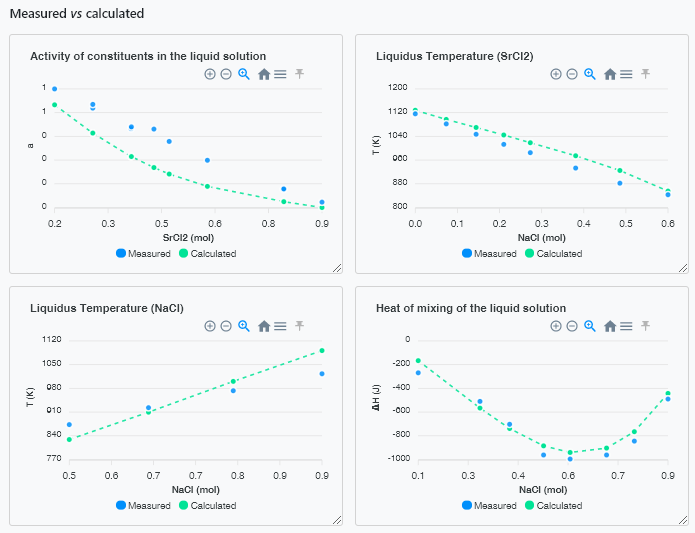
![]()
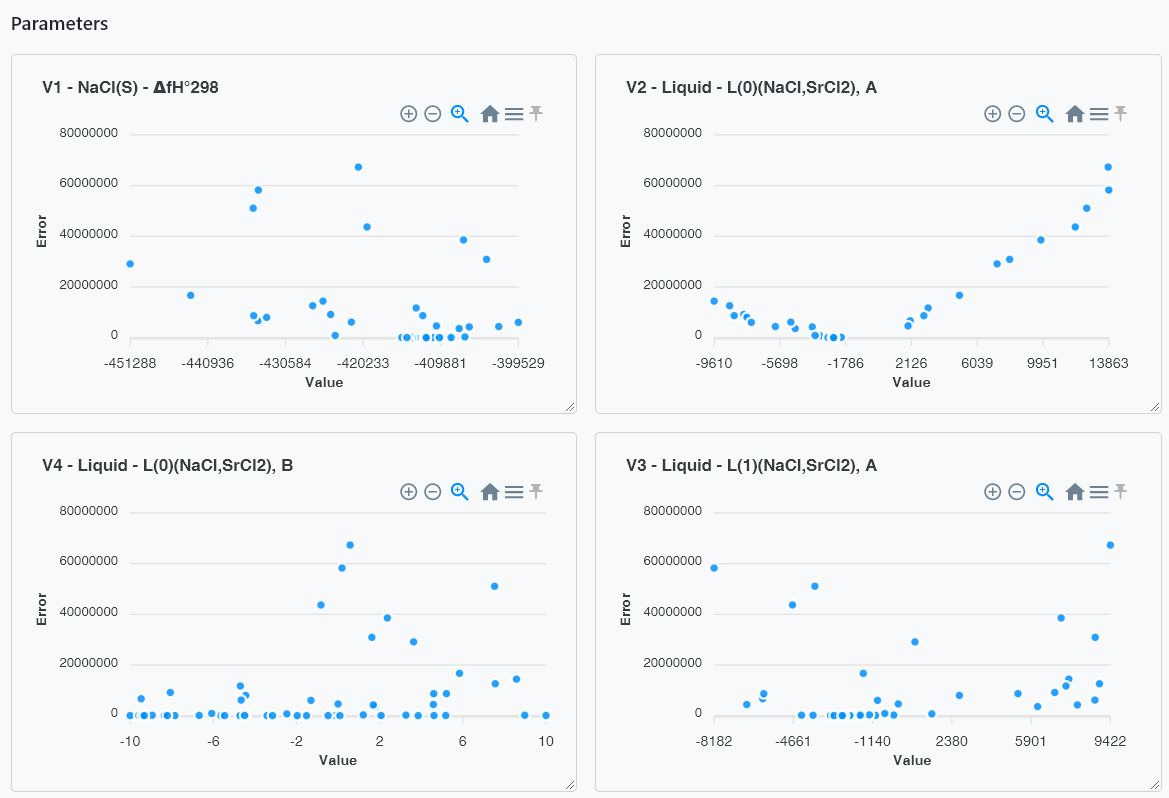
The viscosity algorithm has been completely restructured.
In the FactSage Main Menu Window click Documentation for detailed information on the public compound and solution databases.
LiNO2(s1,s2,l), KLi(NO3)2(s), KLi3(NO2)4(s)
TiB2, NaB5O8, U4F17, NaNO2, Tc
Borax (Na2B4O7(H2O)10) solid, Cr gas, Ca(OH)2 aqueous
TeI4 (data were judged to be questionable),
Li2Al2Si4O12, Fe2Cu2O4, Na2Cr2O4, Sb2O4, Na2Te2 (duplicates of LiAlSi2O6, FeCuO2, NaCrO2, SbO2 and NaTe)
OAlOH (solid duplicate of Al2O3(H2O). OAlOH gas has not been removed.
Ru, Be3N2, UF3, U10C19
For U10C19 the solid Cp has been adjusted to provide better extrapolation to high temperatures.
AlCl3 CaAlCl5 CaFeCl5 CeCl3 CeF3 CoAl2Cl8 FeSiO3_S1
CoF2 CoFe2Cl8 CrAl2Cl8 CrCl2 CrCl3 CrF2 Cs3CeCl6
CsCe2Cl7 FeAl2Cl8 FeCl2 FeCl3 K2CeCl5 K2CoCl4 K2FeCl4
K2PbCl4 K2ZnCl4_S1 K2ZnCl4_S2 K3Ce5Cl18 K3CeCl6 K3Mn2Cl7 K4MnCl6
K5Zn4Cl13 KAlCl4_S1 KAlCl4_S2 KCoCl3 KFeCl3 KFeCl4_S1 KFeCl4_S2
KMnCl3 KNiCl3 KPb2Cl5 KZn2Cl5 LaF3 Li2CoCl4 Li2FeCl4_S1
Li2FeCl4_S2 Li2MnCl4 Li2NiCl4 Li4CoCl6 Li6FeCl8 Li6NiCl8 LiAlCl4
LiCoCl3 LiFeCl4 LuF3_S1 LuF3_S2 MgAl2Cl8 MgFe2Cl8 MnAl2Cl8
MnCl2 MnF2_S1 MnF2_S2 MnFe2Cl8 Na2CoCl4 Na2FeCl4 Na2Mn3Cl8
Na2MnCl4 Na2NiCl4 Na2ZnCl4 Na3Ce5Cl18 Na6MnCl8 Na9Mn11Cl31 NaAlCl4
NaFeCl4 NaMn4Cl9 NiAl2Cl8 NiCl2 NiFe2Cl8 PbCl2 Rb2CeCl5
Rb3CeCl6 RbCe2Cl7 TiAl2Cl8_S1 TiAl2Cl8_S2 TiCl2 ZnCl2
Ag2O Ca3Al2Si3O12 CaAl2SiO6 CaFeSi2O6 Cu2O Fe3Al2Si3O12 Fe3O4_S1
Fe3O4_S2 Fe3O4_S3 Fe3O4_S4 FeO (FeO)2(TiO2) (FeO)(TiO2) FeSiO3_S1
FeSiO3_S2 FeSiO3_S3 Al2Fe2O6 Al2TiO5 Al4TiO8 Ca2FeSi2O7 Ca2Mg2Al28O46
Ca2MgSi2O7 Ca2Ti2O5_S1 Ca2Ti2O5_S2 Ca3Fe2Si3O12 Ca3MgAl4O10 Ca3Ti2O6 Ca3Ti2O7
Ca5Ti4O13 CaFe4O7 CaMg2Al16O27 CaSiTiO5 Fe2Al4Si5O18 FeTi2O4 Mg4Al10Si2O23
Mn2SiO4 K10Mg5Si11O32 K2Ca2Si2O7 K2Ca2Si9O21 K2Ca3Si6O16 K2Ca6Si4O15 K2CaSiO4
K2Mg5Si12O30 K2MgSi3O8_S1 K2MgSi3O8_S2 K2MgSi5O12 K2MgSiO4_S1 K2MgSiO4_S2 K2O
K2Si2O5_S1 K2Si2O5_S2 K2Si2O5_S3 K2Si4O9_S1 K2Si4O9_S2 K2SiO3 K2Ti2O5
K2Ti3O7 K2Ti6O13 K2TiO3 K4CaSi3O9 K4CaSi6O15 K4Mg2Si5O14 K4SiO4
K4TiO4 K8CaSi10O25 K8Ti5O14 KAlO2_S1 KAlO2_S2 MgAl2O4 Mg2TiO4_S1
Mg2TiO4_S2 MgTi2O5 MgTiO3 Mn2Al4Si5O18 Mn2O3_S1 Mn2O3_S2 Mn2TiO4_S1
Mn2TiO4_S2 Mn3Al2Si3O12 MnO2 MnSiO3 MnTi2O4 MnTi2O5 MnTiO3
Na10SiO7 Na2Al12O19 Na2Ca2Si2O7 Na2Ca3Al16O28 Na2Ca3Si6O16 Na2Ca8Al6O18 Na2CaSi5O12
Na2CaSiO4 Na2FeO2 Na2FeSiO4 Na2Mg2Si6O15 Na2MgSi4O10 Na2O_S1 Na2O_S2
Na2O_S3 Na2Si2O5_S1 Na2Si2O5_S2 Na2Si2O5_S3 Na2SiO3 Na2Ti2O5 Na2Ti3O7
Na2Ti6O13 Na2TiO3_S1 Na2TiO3_S2 Na3Fe5O9 Na3FeO3 Na4CaSi3O9 Na4FeO3
Na4SiO4 Na4TiO4 Na5FeO4 Na5FeSi4O12 Na6Si2O7 Na6Si8O19 Na8Ca3Si5O17
Na8Fe2O7 Na8Fe6Si15O40 Na8Ti5O14 NaAlO2_S1 NaAlO2_S2 NaFe2O3 NaFeO2_S1
NaFeSi2O6 Ti10O19 Ti20O39 Ti3O5_S1 Ti3O5_S2 Ti4O7 Ti5O9
Ti6O11 Ti7O13 Ti8O15 Ti9O17 TiO_S1 TiO_S2 Al2O3_S4
MgO
FTlite is designed for thermodynamic and phase equilibrium calculations involving
Al alloys, Mg alloys and Ti alloys.
It can also be used to perform calculations involving mixtures of Li-Na-KMg-Ca-Sr-Ba
with several other elements.
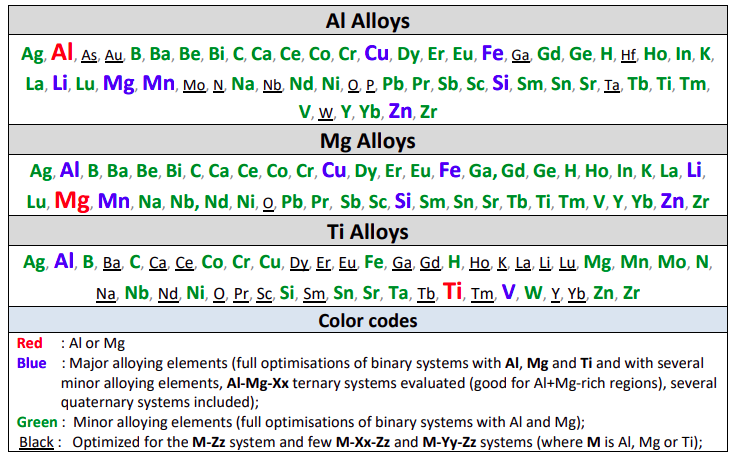
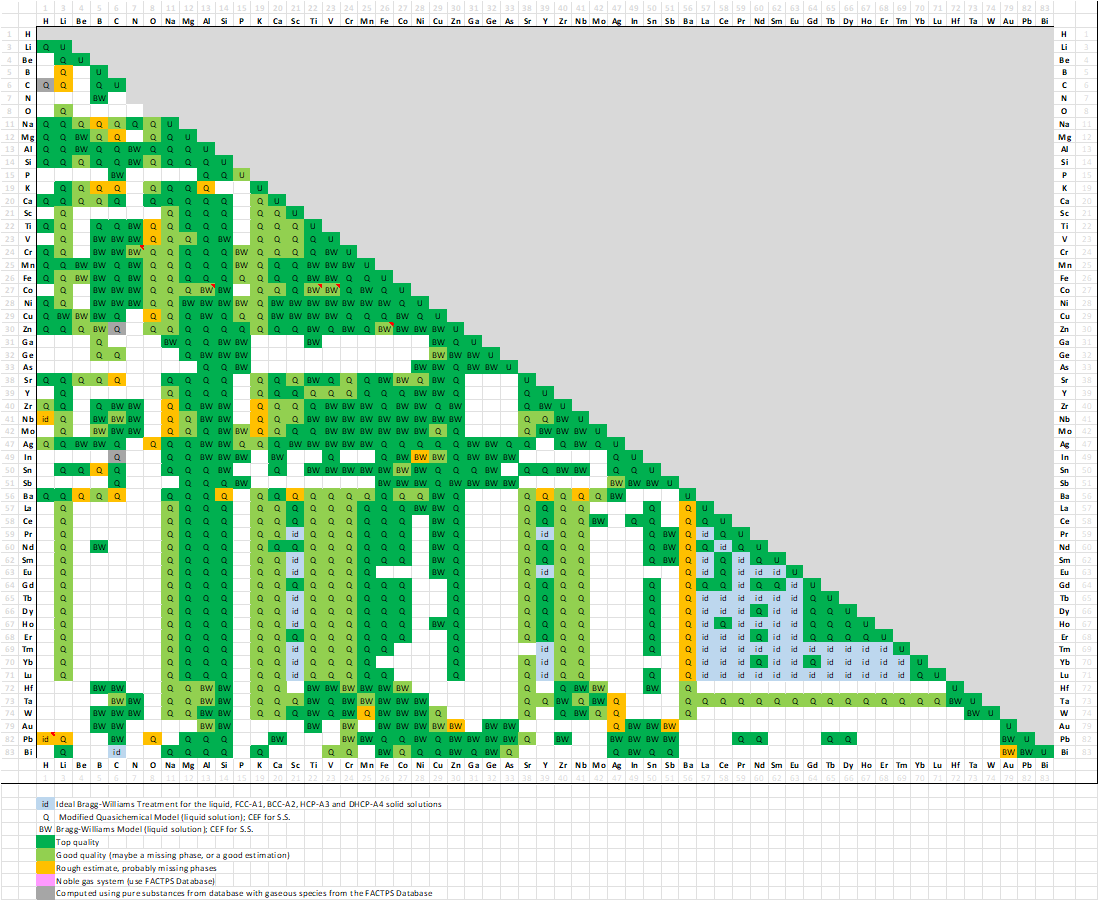
FTlite 8.2 binary assessments
full size
Ag2O Al2O3 Al4C3 AlB2 AlCr2B2 AlCr3B4 AlN
BaB6 BaC2 BN CaB6 CaO Co2B Co3B
CoB CoN CoN3 Cr23C6 Cr2AlC Cr2B Cr2C
Cr2N Cr2O3 Cr3B4 Cr3C Cr3C2 Cr5B3 Cr7C3
CrB CrB2 CrB4 CrN Cu2O Fe2B Fe2N
Fe3B Fe3C Fe3O4_S1 Fe3O4_S2 Fe3O4_S3 Fe3O4_S4 Fe5C2
Fe6W6C Fe7C3 FeB GaN HfB2 InN K2O
KB6 Li2O LiB3 MgAl2O4 MgB2 MgB4 MgB7
MgO Mn23C6 Mn2B Mn2N Mn3AlC Mn3B4 Mn5C2
Mn5SiC Mn6N4 Mn7C3 MnB MnB2 MnB4 MnN
Mo2B Mo2C MoB MoB2 MoB4 MoC Na2C2
Na2O NaB15 Nb2AlC Nb2B3 Nb2C Nb3B2 Nb3B4
Nb5B6 NbB NbB2 Ni2B Ni3B Ni4B3' NiB
NiO Si3N4 SrB6 SrC2 Ta2C TaN Ti2AlC
Ti2C Ti2N Ti3AlC Ti2O Ti3B4 TiB TiB2
TiC TiN TiO V2AlC V2B3 V3B2 V3B4
VB VB2 VN W2B WB WC WN
ZrB ZrB12 ZrB2 ZrC ZrN
The FToxid databases contain data for pure oxides and oxide solutions
of over 20 elements as well as for dilute solutions of S, SO4, PO4, H2O/OH, CO3, F, Cl and I
in the molten (slag) phase.
Ca3Al2Si3O12 CaAl2SiO6 CaFeSi2O6 Fe3Al2Si3O12 (FeO)2(TiO2) (FeO)(TiO2) FeSiO3_S1
FeSiO3_S2 FeSiO3_S3 Al2Fe2O6 Al2TiO5 Al4TiO8 Ca2FeSi2O7 Ca2Mg2Al28O46
Ca2MgSi2O7 Ca2Ti2O5_S1 Ca2Ti2O5_S2 Ca3Fe2Si3O12 Ca3MgAl4O10 Ca3Ti2O6 Ca3Ti2O7
Ca5Ti4O13 CaFe4O7 CaMg2Al16O27 CaSiTiO5 Fe2Al4Si5O18 FeTi2O4 Mg4Al10Si2O23
Mn2SiO4 Ca2Mn3O8 Ca2MnO4 Ca3Mn2O7 Ca4Mn3O10 CaMn2O4 CaMn3O6
CaMn4O8 CaMn7O12 CaMnO3 Cu2O K10Mg5Si11O32 K2Ca2Si2O7 K2Ca2Si9O21
K2Ca3Si6O16 K2Ca6Si4O15 K2CaSiO4 K2Mg5Si12O30 K2MgSi3O8_S1 K2MgSi3O8_S2 K2MgSi5O12
K2MgSiO4_S1 K2MgSiO4_S2 K2O K2Si2O5_S1 K2Si2O5_S2 K2Si2O5_S3 K2Si4O9_S1
K2Si4O9_S2 K2SiO3 K2Ti2O5 K2Ti2Si2O9 K2Ti3O7 K2Ti6O13 K2TiO3
K2TiSi2O7 K2TiSi4O11 K2TiSiO5 K4Ca3Al10O20 K4CaSi3O9 K4CaSi6O15 K4Mg2Si5O14
K4SiO4 K4TiO4 K6MgO4 K8CaSi10O25 K8Ti5O14 KAlO2_S1 KAlO2_S2
KMg2Al15O25 Mg2TiO4_S1 Mg2TiO4_S2 Mg6MnO8 MgTi2O5 MgTiO3 Mn2Al4Si5O18
Mn2O3_S1 Mn2O3_S2 Mn2TiO4_S1 Mn2TiO4_S2 Mn3Al2Si3O12 MnO2 MnSiO3
MnTi2O4 MnTi2O5 MnTiO3 Na10SiO7 Na2Al12O19 Na2Ca2Si2O7 Na2Ca3Al16O28
Na2Ca3Si6O16 Na2Ca8Al6O18 Na2CaSi5O12 Na2CaSiO4 Na2FeO2 Na2FeSiO4 Na2Mg2Si2O7
Na2Mg2Si6O15 Na2Mg5Si12O30 Na2MgSi4O10 Na2MgSiO4 Na2O_S1 Na2O_S2 Na2O_S3
Na2Si2O5_S1 Mg2TiO4_S1 Mg2TiO4_S2 Mg6MnO8 MgTi2O5 MgTiO3 Mn2Al4Si5O18
Na2Ti6O13 Na2Si2O5_S2 Na2Si2O5_S3 Na2SiO3 Na2Ti2O5 Na2Ti2Si2O9 Na2Ti3O7
Na3FeO3 Na2TiO3_S1 Na2TiO3_S2 Na2TiSi2O7 Na2TiSi4O11 Na2TiSiO5 Na3Fe5O9
Na4TiO4 Na4CaSi3O9 Na4Fe6O11 Na4FeO3 Na4Mg2Si3O10 Na4Mg3Si5O15 Na4SiO4
Na8Fe6Si15O40 Na5FeO4 Na5FeSi4O12 Na6Si2O7 Na6Si8O19 Na8Ca3Si5O17 Na8Fe2O7
NaFeSi2O6 Na8Ti5O14 NaAlO2_S1 NaAlO2_S2 NaFe2O3 NaFeO2_S1 NaFeO2_S2
Ti6O11 Ti10O19 Ti20O39 Ti3O5_S1 Ti3O5_S2 Ti4O7 Ti5O9
Ti7O13 Ti8O15 Ti9O17
The new FTsulf databases
contain solutions and stoichiometric compounds in the Cu-Fe-Ni-Co-Cr-Mn-Pb-Zn-As-O-S
system evaluated/optimized by the FACT group for applications involving equilibria among metal, liquid and solid sulfide phases, liquid and solid oxide phases and gas.
This includes pyrometallurgy, hot corrosion, etc. The FTsulf solution database
contains sulfide solutions and three major metal solutions (liquid, bcc and fcc), which are compatible with the sulfide solutions.
The FTsulf compound database contains
all stoichiometric sulfide, sulfate and arsenide compounds evaluated/optimized by the FACT group to be thermodynamically consistent with the FTsulf solution database.
Li, Na, K, Rb, Cs, Mg, Ca, Sr, Ba, Mn, Al, Fe(II), Fe(III), Co, Ni, Zn, Pb, La, Ce, Th,
U(III), U(IV), Pu(III), Pu(IV), Cr(II), Cr(III), Mo(V)
Ag2O AlCl3 CaAlCl5 CaFeCl5 CeCl3 CeF3 CoAl2Cl8
FeSiO3_S1 CoF2 CoFe2Cl8 CrAl2Cl8 CrCl2 CrCl3 CrF2
Cs3CeCl6 CsCe2Cl7 Cu2O FeAl2Cl8 FeCl2 FeCl3 K2CeCl5
K2CoCl4 K2FeCl4 K2O K2PbCl4 K2ZnCl4_S1 K2ZnCl4_S2 K3Ce5Cl18
K3CeCl6 K3Mn2Cl7 K4MnCl6 K5Zn4Cl13 KAlCl4_S1 KAlCl4_S2 KCoCl3
KFeCl3 KFeCl4_S1 KFeCl4_S2 KMnCl3 KNiCl3 KPb2Cl5 KZn2Cl5
LaF3 Li2CoCl4 Li2FeCl4_S1 Li2FeCl4_S2 Li2MnCl4 Li2NiCl4 Li4CoCl6
Li6FeCl8 Li6NiCl8 LiAlCl4 LiCoCl3 LiFeCl4 LuF3_S1 LuF3_S2
MgAl2Cl8 MgFe2Cl8 MgO MnAl2Cl8 MnCl2 MnF2_S1 MnF2_S2
MnFe2Cl8 Na2CoCl4 Na2FeCl4 Na2Mn3Cl8 Na2MnCl4 Na2NiCl4 Na2ZnCl4
Na2O_S1 Na2O_S2 Na2O_S3 Na3Ce5Cl18 Na6MnCl8 Na9Mn11Cl31 NaAlCl4
NaFeCl4 NaFeO2_S1 NaFeO2_S2 NaFeO2_S3 NaMn4Cl9 NiAl2Cl8 NiCl2
NiFe2Cl8 Rb2CeCl5 Rb3CeCl6 RbCe2Cl7 TiAl2Cl8_S1 TiAl2Cl8_S2 TiCl2
TiO_S1 TiO_S2 ZnCl2
MgCl2 PbCl2 MnCl2 CoCl2 NiCl2
In addition the updates to the database include the following changes.
The Li cation has been added to the SALTK liquid solution (which was originally Na, K // NO3, NO2, Cl, CO3, ClO4 in FactSage 8.1).
FScopp is designed for thermodynamic and phase equilibrium calculations involving Cu alloys.
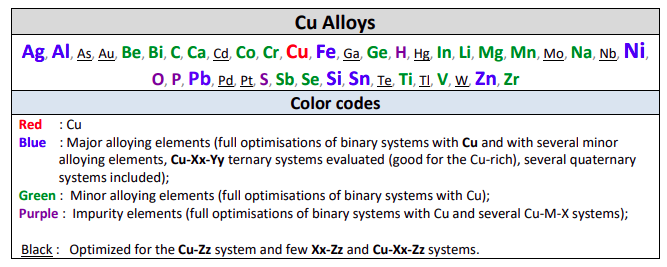
FScopp 8.2 is a major update of the database.
A total of 545 binary systems (vs 422 in 8.2) have been evaluated,
for most of them over the entire range of composition and for all stable phases.
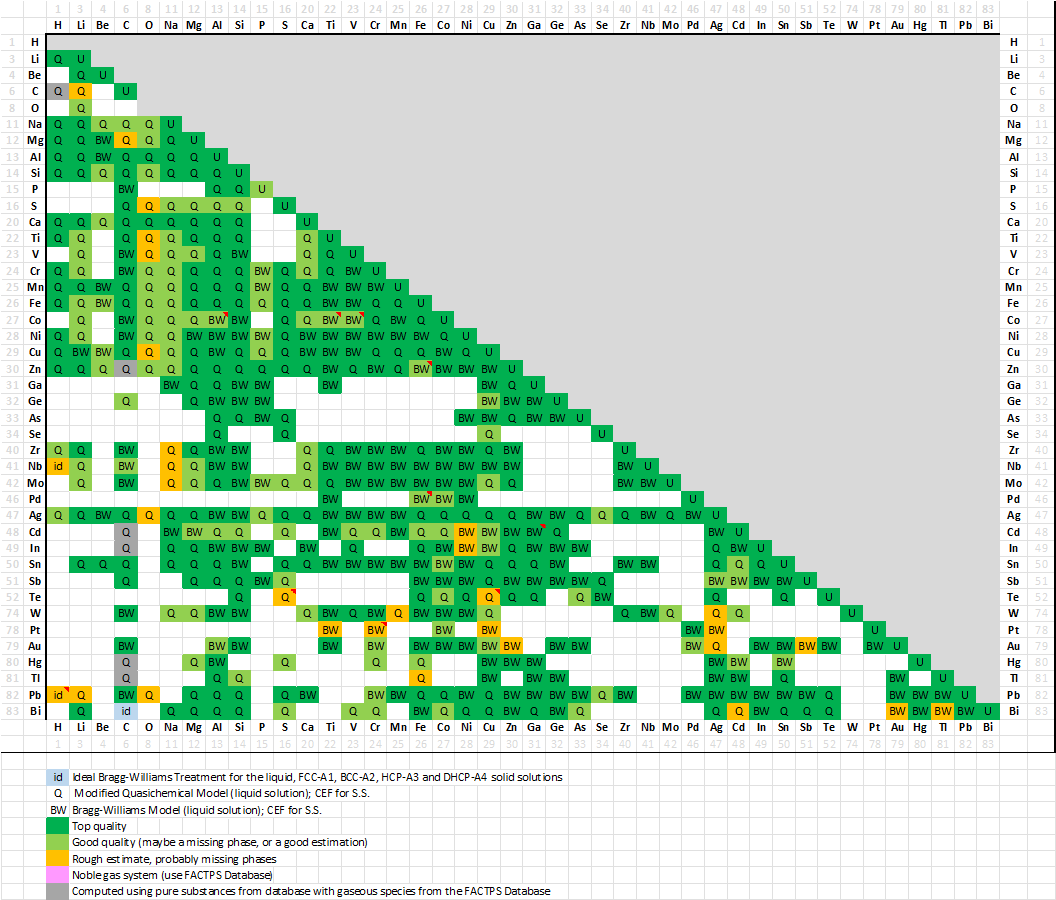
FScopp 8.2 binary assessments
full size
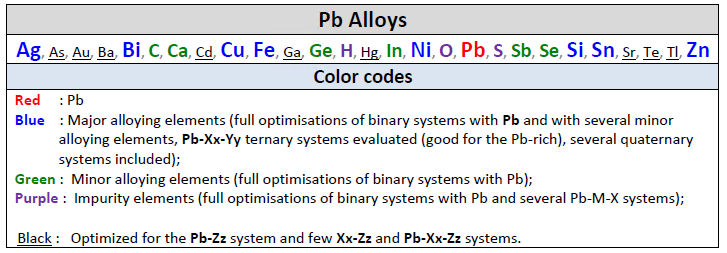
FSlead 8.2 is a major update of the database.
A total of 253 binary systems (vs 161 in 8.1) have been evaluated, for most of them over the entire range of composition and for all stable phases.
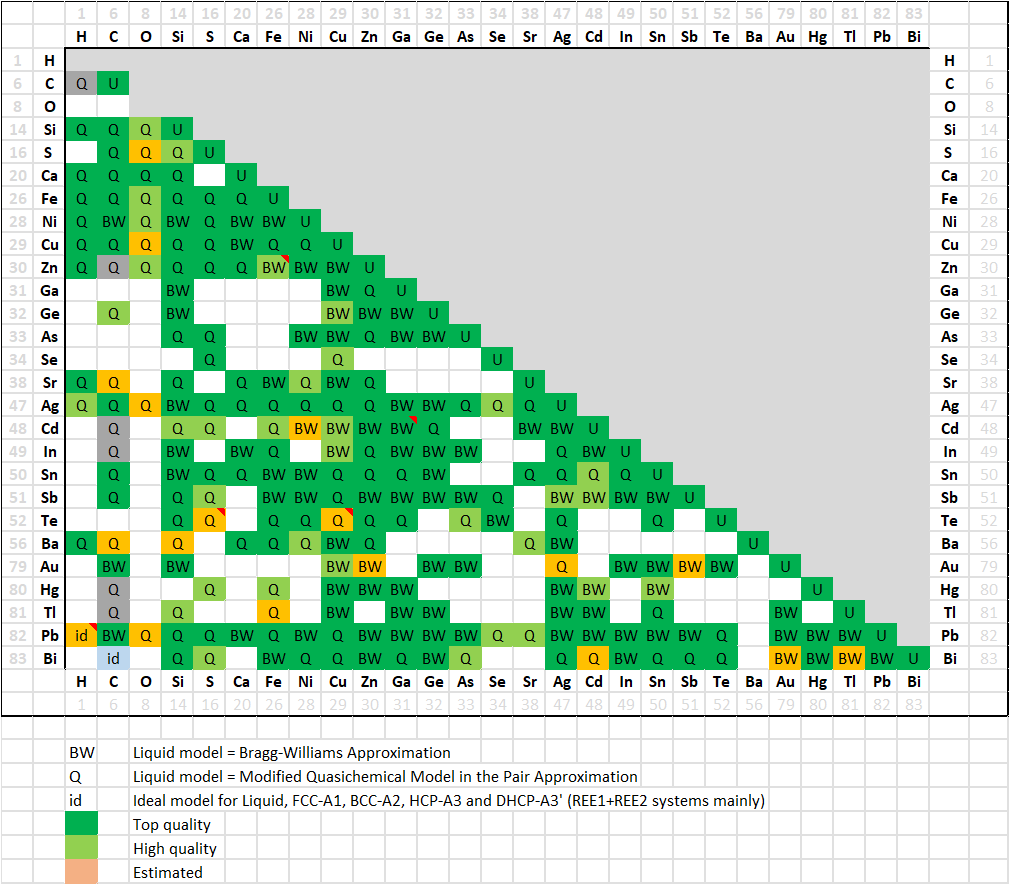
FSlead 8.2 binary assessments
full size
FSstel covers a wide range of commercial grade carbon steels and stainless steels, and new high advanced steels under development.
Al, B, Bi, C, Ca, Co, Cr, Cu, Fe, H, Hf, Mg, Mn, Mo, N, O, Nb, Ni, P, Pb, S, Sb, Si, Sn, Ta, Ti, V, W, Zn, Zr,
RE (Sc, Y, La, Ce, Pr, Nd, Sm, Eu, Gd, Tb, Dy, Ho, Er, Tm, Yb, Lu)
In summary, in FSstel the following systems have been added or updated.
In FactSage 8.2 numerous binary rare-earth systems Fe-RE, Mn-RE, Co-RE, Ni-RE, Si-RE, Al-RE, and Mg-RE
have been added. Many key binary, ternary and multi-component systems covering the Fe-Cr-Mo-Nb-Ni-Ta have been added or updated for improved phase diagram calculations in super alloys.
a. Fe-RE (RE = Ce, Dy, Er, Gd, Ho, La, Lu, Nd, Pr, Sc, Sm, Tb, Tm, Y)
b. Mn-RE (RE = Ce, Dy, Er, Gd, Ho, La, Lu, Nd, Pr, Sc, Sm, Tb, Tm, Y)
c. Co-RE (RE = Ce, Dy, Er, Gd, Ho, La, Nd, Pr, Sm, Y)
d. Ni-RE (RE = Ce, Dy, Er, Gd, Ho, La, Nd, Pr, Sm, Tb, Y)
e. Si-RE (RE = Ce, Dy, Er, Gd, Ho, La, Nd, Pr, Sc, Sm, Tb, Tm, Y)
f. Al-RE (RE = Ce, Dy, Er, Eu, Gd, Ho, Lu, Nd, Pr, Sc, Sm, Tb, Tm, Y, Yb)
g. Mg-RE (RE = Ce, Dy, Nd, Pr, Tb)
a. New Fe-Nd-Dy-B quaternary system including small amount of Pr, Tb, Cu, Ni, Co, etc.,
and reaction with liquid Mg.
b. B-Sn, B-Pb, B-Zn, B-Dy, B-Tb, B-Pr, B-Nd, B-Mg, Mg-Ni, etc.
a. New update of existing binary system: Mo-Ni, Fe-Ta, Ni-Ta, etc.
b. New ternary systems: Cr-Nb-Ni, Mo-Ni-Ta, Fe-Ni-Ta, Mo-Nb-Ni
A minor bug leading to underestimation of stability of pure magnetic elements has been fixed.
All calculated equilibria have been corrected, only the activity information of pure elements might have been wrong.
The SGTE(2022) database is new and represents a significant update and revision of the previous
SGTE(2020) alloy database.
Ag, Al, Am, As, Au, B, Ba, Be, Bi, C, Ca, Cd, Ce, Co, Cr, Cs, Cu, Dy, Er, Eu, Fe, Ga, Gd, Ge, H, Hf, Hg, Ho, In, Ir, K, La, Li, Lu, Mg, Mn, Mo, N, Na, Nb, Nd, Ni, Np, O, Os, P, Pa, Pb, Pd, Pr, Pt, Pu, Rb, Re, Rh, Ru, S, Sb, Sc, Se, Si, Sm, Sn, Sr, Ta, Tb, Tc, Te, Th, Ti, Tl, Tm, U, V, W, Y, Yb, Zn, Zr
SpMCBN contains assessed thermodynamic parameters for binary and ternary alloys of high-temperature materials containing carbon, nitrogen, boron, and silicon. The alloys comprise the following systems:
Me1-Me2-C, Me1-Me2-N, Me1-Me2-B, Me1-Me2-Si, Me-C-N, Me-C-B, Me-C-Si, Me-N-B, Me-N-Si, Me-B-Si, Me1-Me2-Me3
B, C, N, Si with
A minor bug leading to underestimation of stability of pure magnetic elements has been fixed.
All calculated equilibria have been corrected, only the activity information of pure elements might have been wrong.
A minor bug leading to underestimation of stability of pure magnetic elements has been fixed.
All calculated equilibria have been corrected, only the activity information of pure elements might have been wrong.
Screenshot showing the summary of public databases in FactSage 8.2.
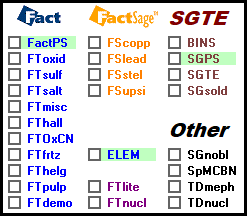
4. Previous FactSage Versions
The following are summaries of the more important programming changes in
Equilib, Phase Diagram, Macro Processing and Databases that have appeared in
FactSage 6.1 (2009), FactSage 6.2 (2010), FactSage 6.3 (2012), FactSage 6.4 (2013),
FactSage 7.0 (2015), FactSage 7.1 (2017), FactSage 7.2 (2018) , FactSage 7.3 (2019),
FactSage 8.0 (2020), FactSage 8.1 (2021) and FactSage 8.2 (2022).
The following are summaries of the more important programming changes in each release.

